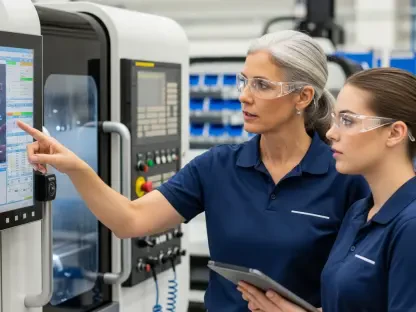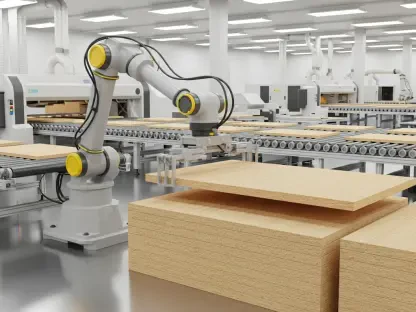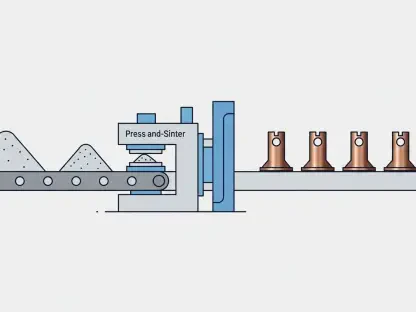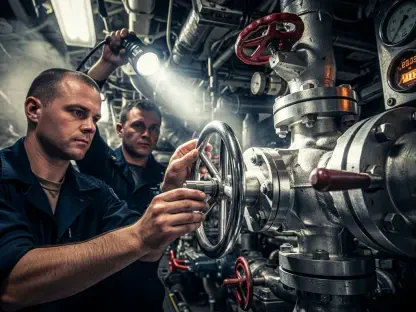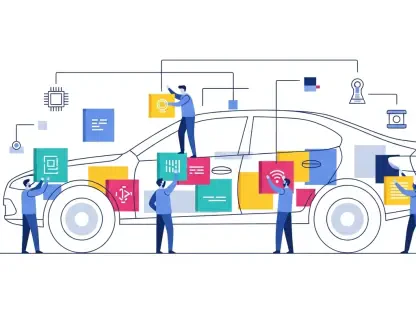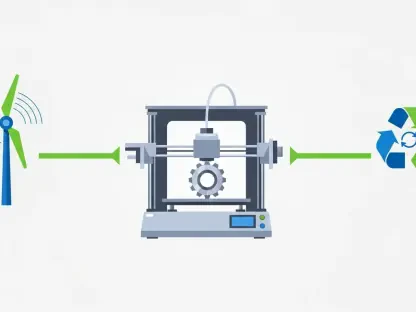In an era where technology is reshaping industries at an unprecedented pace, the newly announced partnership between Samsung Electronics and Nvidia stands out as a monumental stride toward redefining manufacturing through artificial intelligence. This collaboration is not just a business deal; it’s a visionary endeavor to build an “AI Megafactory,” a sophisticated ecosystem designed to transform Samsung’s sprawling global production network that includes semiconductors, mobile devices, and robotics. With Nvidia bringing over 50,000 GPUs to the table, the alliance promises to elevate efficiency and precision to levels previously unimaginable, setting a bold precedent for the future of industrial operations.
This strategic move builds on a decades-long relationship between the two tech titans, aiming to weave AI into every facet of manufacturing, from initial design to final quality checks. Nvidia’s advanced computing power facilitates real-time data analysis and predictive insights, crafting a production environment that operates with minimal human input. Such innovation signals the beginning of what could be an AI-driven industrial revolution, a concept championed by Nvidia’s CEO, Jensen Huang, who envisions a fundamental shift in how industries function. The implications of this partnership extend far beyond immediate operational gains, hinting at a broader transformation across the tech landscape.
AI-Driven Manufacturing Innovation
Redefining Production with AI Integration
The heart of this groundbreaking collaboration lies in the seamless integration of AI across Samsung’s vast manufacturing network, a move set to redefine operational efficiency on a global scale. Nvidia’s powerful GPUs are the backbone of this transformation, enabling real-time data analytics and process optimization that connect every stage of production into a cohesive, intelligent system. From semiconductor fabrication to device assembly, this AI-driven framework minimizes the need for human oversight while maximizing output and accuracy. The result is a self-optimizing environment where machines anticipate issues before they arise, ensuring smoother workflows and reducing costly downtime. This approach not only streamlines Samsung’s operations but also establishes a new benchmark for how technology can enhance industrial processes, pushing the boundaries of what automated systems can achieve in high-stakes environments.
Beyond the technical feats, the integration of AI into manufacturing reflects a strategic vision to stay ahead in a fiercely competitive industry where innovation is the key to survival. Samsung’s adoption of Nvidia’s cutting-edge tools allows for predictive modeling that can foresee production bottlenecks and adapt processes on the fly. This capability is particularly crucial in a sector where delays or defects can lead to significant financial losses and reputational damage. By creating a unified system that communicates across different production phases, the partnership ensures that data isn’t just collected but actively used to drive smarter decision-making. This marks a shift from reactive problem-solving to proactive management, a change that could inspire other manufacturers to follow suit and invest in similar AI-driven solutions to maintain relevance in an ever-evolving market.
Semiconductor Breakthroughs
At the forefront of this alliance are remarkable advancements in semiconductor technology, a critical area where Samsung seeks to solidify its dominance through cutting-edge innovation. High-bandwidth memory solutions like HBM4 are a standout, offering processing speeds that surpass current industry standards, thus enabling faster and more efficient chip performance. Additionally, Nvidia’s software tools, such as cuLitho and CUDA-X, are being utilized for optical proximity correction, resulting in a dramatic boost in computational lithography performance. This leap forward shortens development cycles significantly, allowing Samsung to bring new chips to market at a quicker pace while maintaining high precision. Such progress is vital in an era where demand for advanced semiconductors is skyrocketing across sectors like AI, gaming, and automotive industries.
These semiconductor innovations are more than just technical upgrades; they represent a strategic push to address the growing complexities of modern chip design amid shrinking transistor sizes. The collaboration leverages Nvidia’s expertise in accelerated computing to tackle challenges that traditional methods struggle to overcome, ensuring that Samsung remains a leader in producing chips that power next-generation technologies. The enhanced precision and speed in development not only benefit Samsung’s bottom line but also have ripple effects across the tech ecosystem, enabling faster innovation in devices and applications that rely on cutting-edge semiconductors. As a result, this partnership positions both companies at the forefront of a field that is foundational to virtually every aspect of modern technology, setting a high bar for competitors.
Scaling Operations with Digital Twins and Automation
Virtual Simulations for Real-World Impact
A pivotal element of this transformative partnership is the use of digital twins, virtual replicas of physical manufacturing environments, created through Nvidia’s Omniverse platform to revolutionize operational planning. These simulations allow Samsung to mirror factory setups in a digital space, enabling predictive maintenance, anomaly detection, and strategic planning before any changes are implemented on the actual factory floor. This approach minimizes risks and ensures seamless integration of new processes, a critical advantage in high-volume production settings where errors can be costly. With plans to roll out this technology across global facilities, including Samsung’s hub in Taylor, Texas, the initiative promises to create a synchronized network of AI-enhanced factories that operate with unparalleled foresight and efficiency.
The significance of digital twins extends beyond mere risk reduction; it represents a paradigm shift in how manufacturers approach scalability and adaptability in a dynamic global market. By simulating various scenarios, Samsung can test and refine operational strategies without disrupting active production lines, thereby maintaining continuity while innovating. This data-driven methodology also supports long-term planning by providing insights into potential future challenges, allowing for preemptive solutions. As this technology is deployed across international sites, it will likely serve as a blueprint for other industries looking to modernize their operations through virtual tools, highlighting the far-reaching potential of this collaboration to influence manufacturing standards worldwide.
Robotics and Factory Automation
Another cornerstone of the AI Megafactory vision is the integration of AI into robotics and factory automation, a domain where Nvidia’s advanced platforms are making significant inroads. Systems like the RTX PRO 6000 Blackwell Server Edition and Jetson Thor power autonomous robots and machinery, enabling real-time environmental adaptation and decision-making on factory floors. This technology enhances safety by allowing robots to respond instantly to unexpected changes, reducing the likelihood of accidents in high-risk settings. The result is a production environment where human workers and machines collaborate more effectively, with automation handling repetitive or dangerous tasks while maintaining high standards of precision and reliability.
The impact of AI-driven robotics goes beyond immediate safety and efficiency gains, pointing to a future where intelligent automation becomes the norm in industrial settings. Samsung’s adoption of these technologies ensures that its factories are not just faster but also smarter, with robots capable of learning from their surroundings to optimize workflows continuously. This adaptability is particularly valuable in industries where customization and rapid production shifts are increasingly common, allowing Samsung to meet diverse market demands without sacrificing quality. As automation technology matures through this partnership, it could redefine labor dynamics in manufacturing, paving the way for a new era of productivity where human expertise is complemented by machine intelligence.
Pioneering Connectivity and Industrial Revolution
AI-Powered Mobile Networks
A forward-looking aspect of this collaboration is the development of AI-powered mobile networks through the AI-RAN initiative, which integrates edge AI to revolutionize connectivity in manufacturing. By enabling devices like robots and drones to process data locally, this technology drastically reduces latency and supports real-time responsiveness, a crucial factor for smart factories and mobile automation. Partnering with Korean telecom providers and research institutions, Samsung and Nvidia have already demonstrated the potential of GPU-accelerated, software-based networks through successful proof-of-concepts. This innovation bridges the gap between physical production and digital connectivity, ensuring that data flows seamlessly across systems for maximum operational agility.
The implications of AI-RAN extend into creating a more interconnected industrial ecosystem where responsiveness is paramount to maintaining competitive advantage. Edge AI allows for instantaneous data handling at the source, eliminating delays that could hinder critical processes in automated environments. This capability is especially transformative for applications requiring split-second decisions, such as autonomous machinery coordination or real-time quality control. As this technology scales, it could redefine how connected devices interact within and beyond factory walls, fostering a network of smart systems that communicate and adapt in unison, thus enhancing the overall efficiency of Samsung’s global operations.
Setting New Industry Standards
The broader impact of this partnership heralds what could be described as the onset of an AI industrial revolution, a vision articulated by Jensen Huang as a fundamental reshaping of how industries design, build, and manufacture. This collaboration between Samsung and Nvidia sets a precedent for data-centric production models that prioritize automation and responsiveness, aligning with overarching trends in the tech sector. Their combined efforts position them as trailblazers, compelling other industry players to adopt similar AI-driven strategies to remain competitive. The intelligent infrastructure being developed not only enhances productivity but also creates a seamless connection between industries and consumers through technological advancements.
Reflecting on the strides made, this alliance has already laid a robust foundation for redefining manufacturing norms through AI integration across diverse applications. Looking ahead, the focus should be on expanding these innovations to more facilities worldwide, ensuring that the benefits of AI Megafactories reach a broader spectrum of industries. Continued investment in research and development will be essential to sustain this momentum, alongside fostering collaborations with other tech leaders to tackle emerging challenges. By prioritizing scalability and adaptability, Samsung and Nvidia can drive the next wave of industrial transformation, offering a glimpse into a future where AI is the cornerstone of global production systems.


